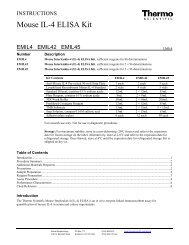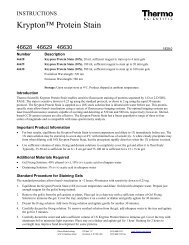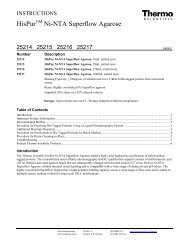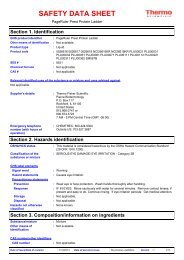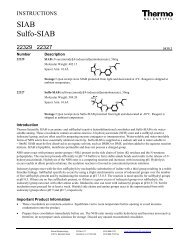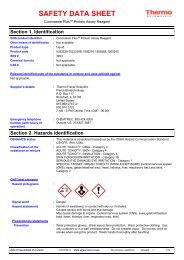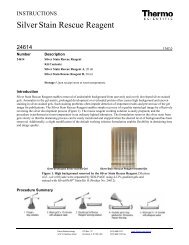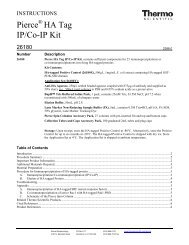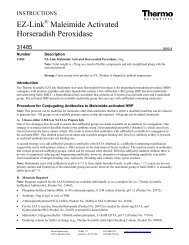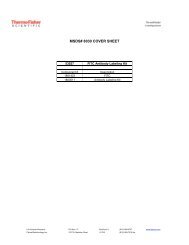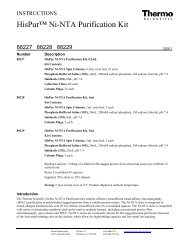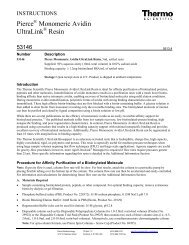Thermo Scientific Pierce Protein Assay Technical Handbook Version 2
Thermo Scientific Pierce Protein Assay Technical Handbook Version 2
Thermo Scientific Pierce Protein Assay Technical Handbook Version 2
You also want an ePaper? Increase the reach of your titles
YUMPU automatically turns print PDFs into web optimized ePapers that Google loves.
Coomassie Dye-based <strong>Protein</strong> <strong>Assay</strong>s<br />
Coomassie Dye-based <strong>Protein</strong> <strong>Assay</strong>s<br />
(Bradford <strong>Assay</strong>s)<br />
Use of Coomassie G-250 Dye in a colorimetric reagent for the<br />
detection and quantitation of total protein was first described<br />
by Dr. Marion Bradford in 1976. Both the Coomassie (Bradford)<br />
<strong>Protein</strong> <strong>Assay</strong> Kit (Product # 23200) and the Coomassie Plus<br />
(Bradford) <strong>Assay</strong> Kit (Product # 23236) are modifications of the<br />
reagent first reported by Dr. Bradford.<br />
Chemistry of Coomassie-based <strong>Protein</strong> <strong>Assay</strong>s<br />
In the acidic environment of the reagent, protein binds to the<br />
Coomassie dye. This results in a spectral shift from the reddish/<br />
brown form of the dye (absorbance maximum at 465nm) to the<br />
blue form of the dye (absorbance maximum at 610nm) (Figure<br />
1). The difference between the two forms of the dye is greatest<br />
at 595nm, so that is the optimal wavelength to measure the blue<br />
color from the Coomassie dye-protein complex. If desired, the<br />
blue color can be measured at any wavelength between 575nm<br />
and 615nm. At the two extremes (575nm and 615nm) there is a<br />
loss of about 10% in the measured amount of color (absorbance)<br />
compared to that obtained at 595nm.<br />
Development of color in Coomassie dye-based protein assays<br />
has been associated with the presence of certain basic amino<br />
acids (primarily arginine, lysine and histidine) in the protein. Van<br />
der Waals forces and hydrophobic interactions also participate<br />
in the binding of the dye by protein. The number of Coomassie<br />
dye ligands bound to each protein molecule is approximately<br />
proportional to the number of positive charges found on the<br />
protein. Free amino acids, peptides and low molecular weight<br />
proteins do not produce color with Coomassie dye reagents. In<br />
general, the mass of a peptide or protein must be at least 3,000<br />
daltons to be assayed with this reagent. In some applications this<br />
can be an advantage. The Coomassie (Bradford) <strong>Protein</strong> <strong>Assay</strong><br />
has been used to measure “high molecular weight proteins”<br />
during fermentation in the beer brewing industry.<br />
PROTEIN<br />
Basic and Aromatic<br />
Side Chains<br />
Coomassie G-250<br />
BLUE<br />
465nm<br />
<strong>Protein</strong>-Dye Complex<br />
A max = 595nm<br />
Figure 1. Reaction schematic for the Coomassie dye-based protein assays (the Coomassie [Bradford] <strong>Protein</strong> <strong>Assay</strong> and the Coomassie Plus<br />
(Bradford) <strong>Assay</strong>).<br />
Advantages of Coomassie-based <strong>Protein</strong> <strong>Assay</strong>s<br />
Coomassie dye-binding assays are the fastest and easiest to<br />
perform of all protein assays. The assay is performed at room<br />
temperature and no special equipment is required. Briefly, for<br />
either the Coomassie (Bradford) <strong>Protein</strong> <strong>Assay</strong> or the Coomassie<br />
Plus <strong>Assay</strong>, the sample is added to the tube containing reagent<br />
and the resultant blue color is measured at 595nm following a<br />
short room-temperature incubation. The Coomassie dye-containing<br />
protein assays are compatible with most salts, solvents, buffers,<br />
thiols, reducing substances and metal chelating agents encountered<br />
in protein samples.<br />
Disadvantages of Coomassie-based <strong>Protein</strong> <strong>Assay</strong>s<br />
The main disadvantage of Coomassie-based protein assays is<br />
their incompatibility with surfactants at concentrations routinely<br />
used to solubilize membrane proteins. In general, the presence<br />
of a surfactant in the sample, even at low concentrations, causes<br />
precipitation of the reagent. Since the Coomassie dye reagent is<br />
highly acidic, a small number of proteins cannot be assayed with<br />
this reagent due to their poor solubility in the acidic reagent. Also,<br />
Coomassie reagents result in about twice as much protein:protein<br />
variation as copper chelation based assay reagents (Table 2,<br />
page 9). In addition, Coomassie dye stains the glass or quartz<br />
cuvettes used to hold the solution in the spectrophotometer<br />
while the color intensity is being measured. (Cuvettes can be<br />
cleaned with strong detergent solutions and/or methanol washes,<br />
but use of disposable polystyrene cuvettes eliminates the need to<br />
clean cuvettes.)<br />
To order, call 800-874-3723 or 815-968-0747. Outside the United States, contact your local branch office or distributor.<br />
21



